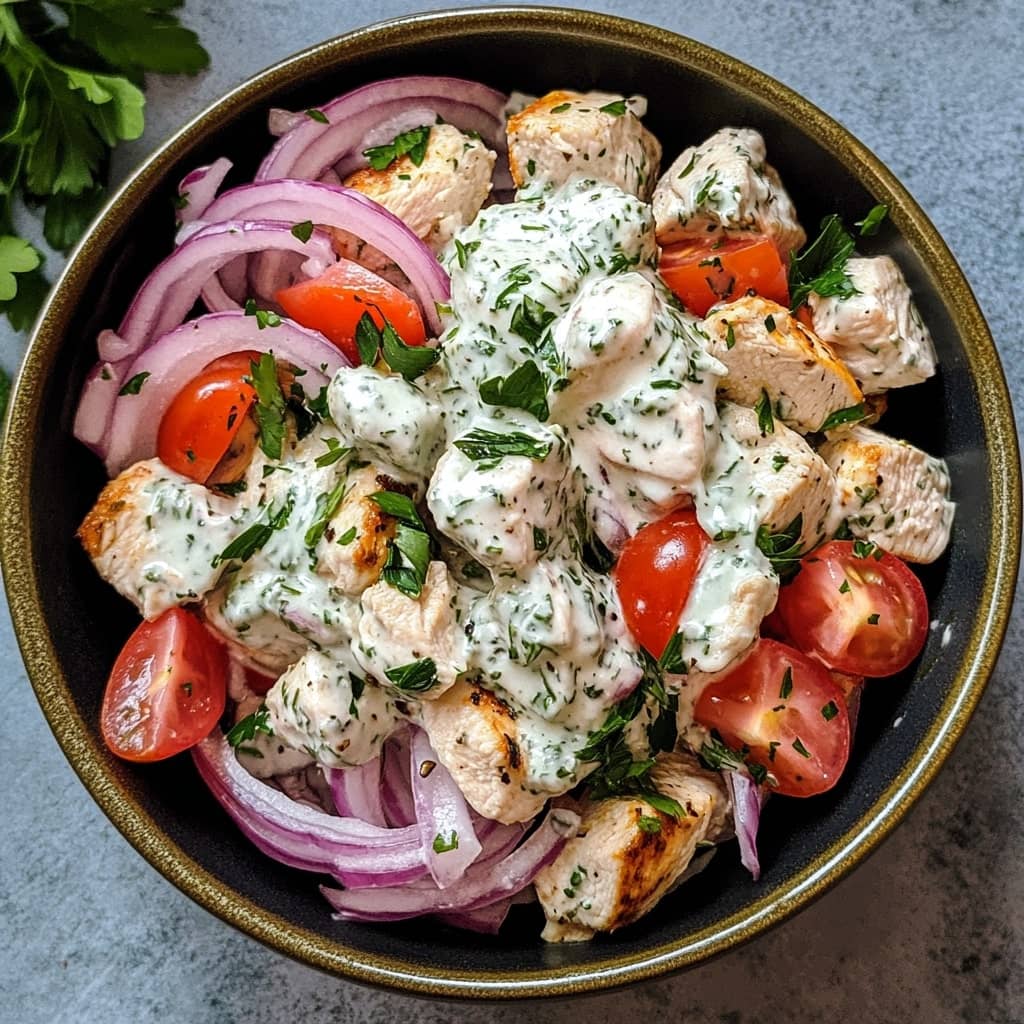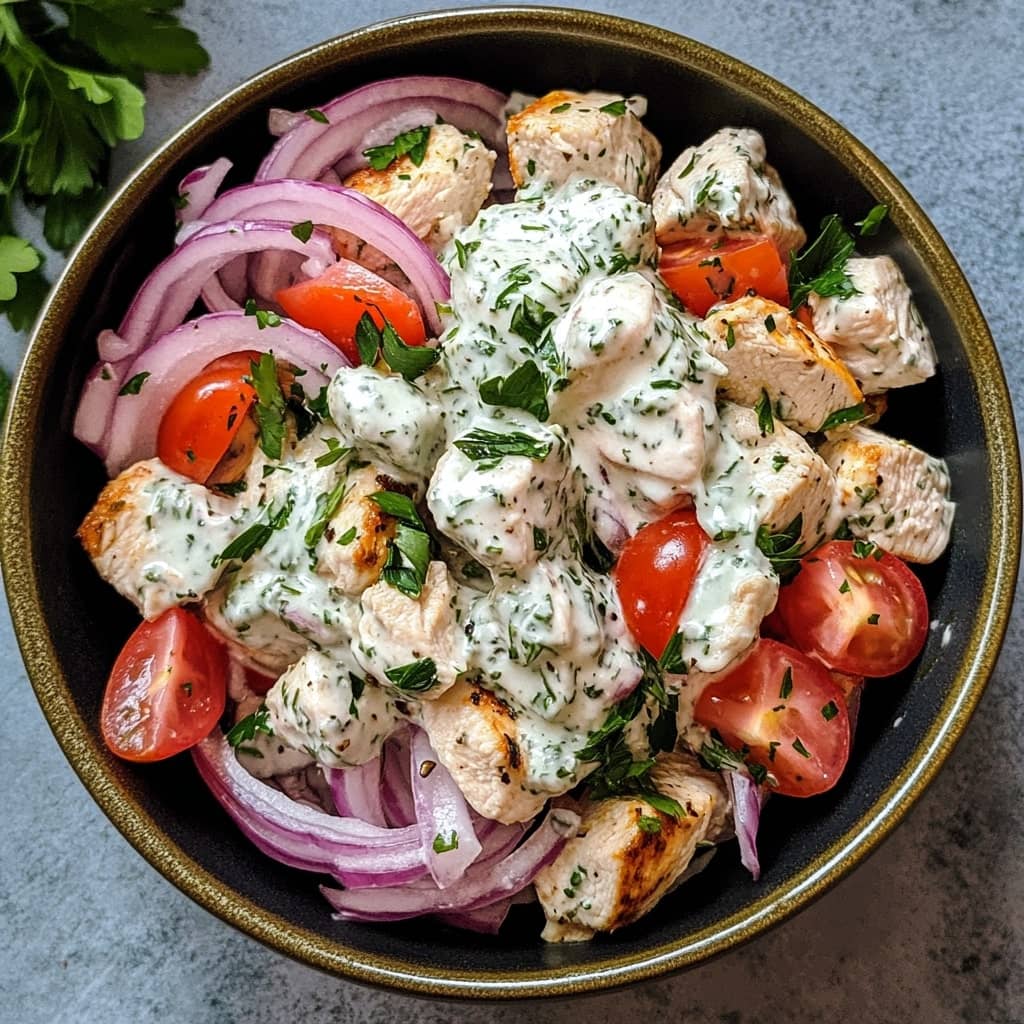Tzatziki Chicken Salad is a refreshing, protein-rich dish that fuses the creamy, herbaceous flavors of traditional Greek tzatziki with tender, juicy chicken and crisp vegetables. Whether served chilled as a light lunch, packed in a pita for a hearty sandwich, or plated over greens for a satisfying dinner, this salad captures the vibrant, Mediterranean essence in every bite. It’s a staple for those seeking a low-carb, nutrient-dense meal that’s both filling and flavorful, with a creamy texture and a zesty, garlicky tang. Tzatziki Chicken Salad has gained popularity around the world for its ease of preparation, health benefits, and ability to adapt to various dietary needs, making it a go-to for health-conscious food lovers and home cooks alike.
The History of Tzatziki Chicken Salad
The roots of tzatziki stretch deep into the culinary traditions of Southeast Europe and the Middle East, where variations of the yogurt-based sauce have existed for centuries. The Greek version, known as tzatziki, typically includes strained yogurt, cucumber, garlic, olive oil, lemon juice, and fresh herbs like dill or mint. Originally used as a cooling accompaniment to grilled meats and spicy dishes, tzatziki’s refreshing properties made it a favorite in hot climates. The pairing of tzatziki with chicken likely evolved more recently, particularly in Western countries where healthy eating trends inspired creative uses of traditional sauces in low-carb or high-protein recipes. The modern Tzatziki Chicken Salad likely emerged in the 21st century, popularized by the Mediterranean diet movement and food bloggers who sought to blend classic flavors with modern nutrition principles. Today, it stands as a delicious fusion of heritage and health, cherished for its balance of taste, texture, and nutritional value.
Ingredients Breakdown
Chicken: Use boneless, skinless chicken breasts or thighs. Grilled, poached, or rotisserie chicken can all work depending on your preference. Chicken is a lean source of protein and serves as the hearty base of the salad.
Tzatziki Sauce: Typically made from Greek yogurt, cucumber, garlic, lemon juice, olive oil, and dill or mint. Use full-fat yogurt for a creamier texture or low-fat for fewer calories.
Cucumber: Adds crunch and freshness. English cucumbers or Persian cucumbers are best, as they have fewer seeds and a thinner skin.
Red Onion: Provides sharpness and a touch of sweetness. For a milder flavor, soak sliced onions in water for 10 minutes before adding.
Cherry Tomatoes: Adds a pop of sweetness and color. Optional but recommended for a summery twist.
Fresh Herbs: Dill is traditional, but parsley or mint can also work well. Fresh herbs enhance the vibrancy of the salad.
Olives: Kalamata or black olives add briny depth and authenticity to the Mediterranean flavor.
Feta Cheese: Optional, but a great addition for richness and a salty bite.
Lemon Juice: Brings brightness and cuts through the creaminess of the yogurt.
Salt and Pepper: Essential for seasoning and bringing all the flavors together.
Step-by-Step Recipe
- Cook the Chicken: Season 2-3 boneless, skinless chicken breasts with salt, pepper, and optional garlic powder. Grill over medium heat for about 6-7 minutes per side, or bake at 375°F (190°C) for 25 minutes until cooked through. Let cool, then dice or shred.
- Prepare the Tzatziki: In a bowl, mix 1 cup of Greek yogurt, 1/2 grated cucumber (squeezed dry), 1 minced garlic clove, 1 tbsp lemon juice, 1 tbsp olive oil, and 1 tbsp chopped dill. Season with salt and pepper. Let sit for 10-15 minutes in the fridge to allow flavors to meld.
- Combine Ingredients: In a large bowl, combine the chopped chicken, 1/2 cup chopped cucumber, 1/4 cup finely diced red onion, 1/2 cup halved cherry tomatoes, 1/4 cup chopped olives, and 1/4 cup crumbled feta (if using).
- Add the Tzatziki: Pour the prepared tzatziki over the chicken mixture and stir until everything is evenly coated. Taste and adjust seasoning if necessary.
- Chill and Serve: Cover and refrigerate for at least 30 minutes to let flavors meld. Serve in lettuce cups, over greens, in a wrap, or with pita chips.
Tips for the Perfect Tzatziki Chicken Salad
Use freshly squeezed lemon juice and high-quality olive oil for the best flavor. Let the tzatziki rest before mixing it with the salad to develop its full flavor. Squeeze as much water as possible out of the grated cucumber to avoid a watery dressing. Dice vegetables uniformly for consistent texture and presentation. Let the salad chill before serving to enhance flavor integration and improve texture. Use grilled chicken for a smoky note, or rotisserie chicken for convenience and extra flavor. Make a double batch of tzatziki to use as a dressing or dip later in the week. Add the tzatziki gradually to avoid overdressing—better to underdress and add more later. Garnish with extra herbs, a drizzle of olive oil, or a sprinkle of paprika for presentation.
Variations and Customizations
Low-Carb/Keto: Use full-fat Greek yogurt and skip the tomatoes or onions to reduce carbs.
Paleo: Substitute dairy-free yogurt (like coconut or almond) and omit feta cheese.
Vegan: Replace chicken with chickpeas or tofu and use a plant-based yogurt.
Spicy: Add chopped jalapeños or a dash of cayenne pepper to the tzatziki.
Crunch Factor: Mix in chopped nuts like almonds or walnuts, or top with crispy chickpeas.
Wraps & Sandwiches: Stuff the salad in pita bread, tortillas, or lettuce wraps for a portable option.
Add Grains: Include quinoa or farro for added fiber and a heartier meal.
Different Proteins: Swap chicken for turkey, shrimp, or even grilled tofu.
International Flair: Add spices like sumac, za’atar, or cumin for a different flavor profile.
Health Considerations and Nutritional Value
Tzatziki Chicken Salad is rich in lean protein and probiotics, especially when made with Greek yogurt. It’s low in carbohydrates and high in essential nutrients like calcium, vitamin B12, and potassium. Cucumbers and fresh vegetables provide hydration and fiber, supporting digestion and satiety. Greek yogurt offers live cultures that may aid gut health. Olive oil brings heart-healthy monounsaturated fats and antioxidants. The dish is naturally gluten-free and can easily be adapted for dairy-free, low-fat, or high-protein diets. With moderate sodium levels (especially if using olives and feta), it’s suitable for most people watching their salt intake. It’s an excellent choice for weight management, muscle maintenance, and overall metabolic health.
FAQ
Can I make it ahead? Yes, it keeps well for 3-4 days in the refrigerator.
Can I freeze it? Freezing is not recommended due to the yogurt base separating upon thawing.
What can I serve it with? Serve with pita, on lettuce, or in wraps. It pairs well with tabbouleh or quinoa.
Is it safe for kids? Yes, but consider reducing the garlic if they’re sensitive to strong flavors.
How do I store leftovers? Store in an airtight container in the fridge; stir before serving again.
Can I use leftover rotisserie chicken? Absolutely! It’s a time-saving option and adds extra flavor.
What type of yogurt should I use? Greek yogurt is best for its thick texture, but regular yogurt can work if strained.
What if I don’t like dill? Substitute with parsley, mint, or even basil for a different herbal note.
Is it good for meal prep? Yes, it holds up well and doesn’t get soggy like other salads.
Is it keto-friendly? Very much so, especially with full-fat yogurt and without added carbs like bread.

Tzatziki Chicken Salad
Ingredients
Method
- In a large mixing bowl, combine all the tzatziki ingredients and stir until thoroughly mixed.
- Add the rest of the salad ingredients to the bowl and mix until everything is evenly coated in the tzatziki. Taste and adjust the seasoning with more salt, pepper, or lemon juice as needed.
- Serve the chicken salad in pita bread, over romaine or mixed greens, or with any of your preferred serving options mentioned above.
